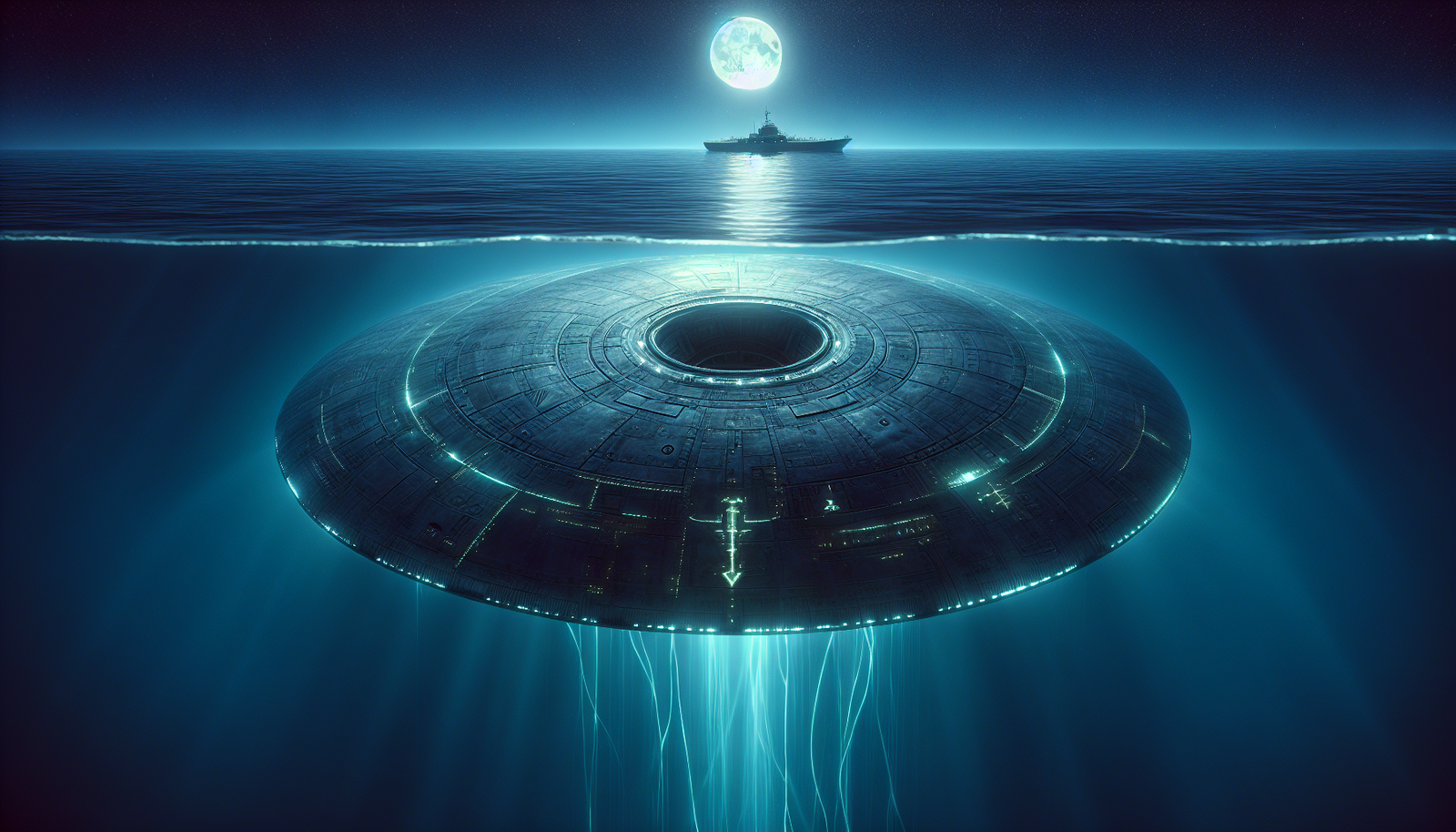USOs (Unidentified Submerged Objects): Secrets Below

By Sanjay Kapoor, Ufologist
In July 2019, the USS Omaha captured something extraordinary on its advanced optical system. The infrared camera tracked a spherical object hovering just above the Pacific Ocean before it suddenly plunged into the water with a splash. "It splashed!" exclaimed one of the sailors in the verified Pentagon footage. Within seconds, the object simply vanished beneath the waves—no wreckage, no debris, no explanation.
This wasn't science fiction. This was a documented encounter between the U.S. Navy and what experts now classify as a USO—an Unidentified Submerged Object.
While most of us are familiar with UFOs (Unidentified Flying Objects), their underwater counterparts remain relatively unknown to the public. Yet these mysterious phenomena might ultimately prove more significant than their aerial cousins. Why? Because they operate in what remains Earth's final frontier—our oceans.
"Pilots, credible observers, and calibrated military instrumentation have recorded objects accelerating at rates and crossing the air-sea interface in ways not possible for anything made by humans," explains Timothy Gallaudet, former oceanographer of the U.S. Navy and retired Rear Admiral. He warns these phenomena represent an "urgent national security concern with world-changing scientific ramifications."
Consider this: we've mapped the entire surface of Mars in greater detail than our own ocean floor. Nearly 95% of Earth's oceans remain unexplored. If something—or someone—wanted to remain hidden from human detection, there's no better place than the crushing depths where sunlight never penetrates.
In 2022, the Pentagon quietly acknowledged this reality by changing its terminology from "Unidentified Aerial Phenomena" to "Unidentified Anomalous Phenomena," specifically to include objects operating underwater. Something strange is happening beneath the waves, and after decades of dismissal, governments are finally paying attention.
Beyond the Flying Saucer: What Exactly Are USOs?
USOs represent the aquatic equivalent of UFOs—mysterious objects or detection phenomena observed underwater that defy conventional explanation even after investigation. However, many researchers consider USOs and UFOs to be manifestations of the same phenomenon in different mediums.
Military officials now use the term "transmedium" to describe objects capable of operating with equal facility in air and water—a technological feat that remains beyond human engineering capabilities. The seamless transition between these environments poses a fundamental physics problem: water is approximately 800 times denser than air. Any conventional craft hitting water at high speed would experience what amounts to a solid impact, yet USOs reportedly move between these mediums without slowing down.
USO encounters generally fall into four categories:
- Objects entering water from air (like the USS Omaha incident)
- Objects emerging from water into air
- Objects exclusively detected underwater
- Stationary underwater structures or potential bases
What makes USOs particularly baffling is their reported capabilities. Unlike conventional submarines that struggle to exceed 30 knots, USOs reportedly travel at "several hundred knots" underwater. They make instant, right-angle turns that would generate crushing g-forces. They operate at depths where water pressure would implode even our most advanced submarines. And perhaps most puzzlingly, they do all this without creating the telltale cavitation bubbles, acoustic signatures, or wakes that physics demands.
Ancient Mariners: Historical USO Accounts
Long before modern sonar and submarine technology, sailors across cultures reported strange encounters beneath the waves. One of the oldest potential accounts comes from Aboriginal Australia, where the Wanjina legend from the Kimberley region describes beings that "came from the sky, lived underwater, and had full mastery of the water." Dating back approximately 5,000 years, these stories describe entities with capabilities remarkably similar to modern USO reports.
Even Christopher Columbus documented a possible USO. On October 11, 1492—just hours before first sighting land in the Bahamas—Columbus recorded observing "a light glimmering at a great distance" that appeared to rise from and fall back into the water, "like a little wax candle rising and falling." This strange light was also witnessed by another crew member, Pedro Gutierrez.
By 1644, we find John Winthrop writing in his diary about three men in Boston who observed "two lights arise out of the water near the North Point of the Town Cove in form like a man and went at a small distance to the town and so to the South Point and there vanished away." This represents one of the earliest documented USO sightings in what would become the United States.
The pattern continues throughout maritime history. On June 18, 1845, the crew of the brigantine Victoria reportedly saw "three luminous bodies emerge from the sea into the air" about 900 miles east of Adalia. In 1870, sailors aboard the English corvette Lady of the Lake observed a strange "lenticular cloud with a long tail" moving against the wind in Atlantic equatorial waters. Captain F.W. Banner's drawing in the ship's log bears an uncanny resemblance to what we now recognize as a classic flying saucer.
What's remarkable about these historical accounts isn't just their content but their consistency. Centuries before the term "flying saucer" entered our lexicon, sailors worldwide were describing luminous objects moving between sea and sky with technologies impossible for their era.
Making Waves: Landmark USO Cases
Among documented USO encounters, few are as compelling as the 1967 Shag Harbour incident—often called "the Canadian Roswell." On October 4, at approximately 11:20 p.m., at least eleven people observed a low-flying object descend and crash into the waters near Shag Harbour, Nova Scotia.
Witnesses described an object about 60 feet long, hovering and displaying flashing orange lights, before it tilted at a 45-degree angle and plunged into the water. Several reported hearing a whistling sound "like a bomb," followed by a "whoosh," and finally a loud bang.
When authorities arrived, they observed a pale yellow light bobbing on the water's surface before it sank from view. The subsequent search found only a yellow foam approximately 80 feet wide and half a mile long floating on the surface. What elevates this case above mere anecdote is the official Canadian government involvement—the Canadian Maritime Command dispatched divers who searched for three days, and government documents concerning the incident explicitly used the term "UFO" and stated that conventional explanations had been ruled out.
Even more intriguing are claims from military witnesses who suggested that after leaving Shag Harbour, the object traveled underwater up the coast to Shelburne (site of a top-secret submarine detection base), where it was allegedly tracked by radar and sonar for several days. The Canadian Department of National Defence has officially classified this sighting as "unsolved."
More recently, the Baltic Sea Anomaly discovered in 2011 by Swedish treasure hunters Peter Lindberg and Dennis Åsberg continues to puzzle researchers. Their sonar detected a remarkably circular object approximately 60 meters in diameter with unusual features sitting about 300 feet below the surface. Most striking are what appear to be "skid marks" on the seabed leading up to it, as if something had crashed and then skidded to a stop. While geologists suggest it might be a natural formation, the object's regular structure and the surrounding evidence have fueled ongoing speculation.
In 1982, Lake Baikal in Siberia—the world's deepest freshwater lake—became the site of another extraordinary encounter when Russian military divers reportedly encountered humanoid beings in strange shiny suits underwater. According to former Navy officer Vladimir Azhazha, "Fifty percent of UFO encounters are connected with oceans. Fifteen more - with lakes. So, UFOs tend to stick to the water." Though anecdotal, such reports from trained military personnel with nothing to gain from fabrication add to the growing body of evidence suggesting something unusual may indeed operate in our waters.
Silent Service: Military Encounters with the Unknown
Military vessels, with their advanced detection equipment and trained personnel, have provided some of the most compelling USO documentation. In 1952, crew aboard the USS Franklin D. Roosevelt reported witnessing a metallic object rise from the water and ascend into the sky. Curiously, at the time of these sightings, the USS FDR was the only ship carrying nuclear weapons, raising questions about whether these weapons might attract USO attention.
Professor Bob McGwier of Virginia Tech has claimed that while aboard the fast-attack submarine USS Hampton doing classified work, the vessel's sonar detected an object moving through the water faster than the speed of sound. "When I left there with the knowledge in my head, not having been told to be quiet, not having been told it was classified... It is mine to tell whoever I want. They blew it," McGwier stated in an interview with UAP Encounters. The encounter reportedly lasted just a few seconds but left a lasting impression.
The USS Stein incident of 1978 presents an even stranger case. The vessel experienced increased sonar noise, and inspection revealed that the protective rubber coating on its sonar dome had several cuts containing remnants of claws. These claws resembled those found in the suction cups on giant squid tentacles but were significantly larger than any specimens previously collected by scientists. Whatever had attacked the destroyer escort was substantially larger than any documented cephalopod.
Perhaps most revelatory is the experience of Mark D'Antonio, an astronomer and U.S. Navy contractor who was invited aboard a nuclear submarine. While sitting in the sonar section, D'Antonio witnessed a sonar operator suddenly call out "Fast mover, fast mover!" When asked about the object's speed, the operator reported "several hundred knots"—far beyond the capabilities of any known underwater craft. According to D'Antonio, the executive officer simply responded, "Log it and dog it," suggesting an established protocol for such inexplicable contacts.
D'Antonio later asked a senior naval figure about what he calls "the Fast Mover Program," to which the official reportedly replied, "Sorry Marc, I can't talk about that program"—effectively confirming its existence without saying a word. This response suggests that naval forces have systems in place for cataloging underwater anomalies they cannot explain.
Between 1958 and 1960, the Argentine Navy conducted three separate extensive hunts for unidentified submarines in the Golfo Nuevo. Despite deploying up to 14 warships (including an aircraft carrier) and over 30 navy planes, the submarines remained elusive. Though audible and occasionally visible, they could not be detected by sonar, sonar buoys, hydrophones, or radar. Most puzzling was their apparent immunity to depth charges and torpedoes. Despite intensive bombing with advanced weapons, the hunt was abandoned without success.
These military encounters share a common theme: highly trained personnel with sophisticated equipment detecting objects that operate by rules that seem to defy our understanding of physics.
Breaking the Rules: The Physics-Defying Capabilities of USOs
What makes USOs particularly baffling to researchers and military officials are their reported capabilities, which seem to violate fundamental laws of physics as we understand them.
First is the question of speed. Water resistance increases exponentially with velocity—at high speeds, the pressure difference creates cavitation bubbles that collapse violently, producing noise and potentially damaging any vehicle. Conventional nuclear submarines typically reach maximum speeds of about 25-30 knots when submerged. Even the most advanced torpedoes, like the Russian VA-111 Shkval, can only achieve speeds around 200 knots by creating a steam bubble around themselves to reduce water resistance.
Yet USOs are repeatedly reported traveling at "several hundred knots" without creating the extreme noise and cavitation bubbles physics demands. They move silently and leave no wake or disturbance pattern behind them.
Even more puzzling is their reported ability to transition between water and air without slowing down. Water is approximately 800 times denser than air—any conventional craft hitting water at high speed would experience what amounts to a solid impact. Yet witnesses describe objects entering or exiting water at high speeds without deceleration and often without even creating a splash.
In Norway, Sweden, and Russia, reports describe objects flying into and out of ice-covered waters as if the ice presented no barrier whatsoever. Afterward, investigators sometimes find large holes in the ice that don't appear to be the result of impact trauma, suggesting these objects somehow melt or phase through solid matter.
Perhaps most impressive is their apparent ability to operate at extreme depths—as deep as 20,000 feet below the surface. At such depths, water pressure exceeds 9,000 pounds per square inch, far beyond the crush depth of even the most advanced military submarines. To withstand such pressure would require materials far stronger than anything in our current engineering repertoire or some method of neutralizing pressure effects altogether.
When detected on sonar, USOs often produce unusual signatures unlike conventional vessels. According to one submarine sonar operator known by the handle "Jive Turkey," these anomalous contacts typically appear as "a very fine line developing on the sonar" and may last only a few seconds—too brief to accurately measure speed but enough to confirm they're unlike anything operators are trained to recognize.
Beneath the Surface: Theories and Explanations
So what exactly are USOs? Theories range from the mundane to the extraordinary, each with supporting evidence and critical weaknesses.
The extraterrestrial hypothesis remains most popular among researchers. Proponents argue that if alien civilizations are visiting Earth, the oceans would provide an ideal hiding place. They cover over 70% of our planet's surface, and their depths remain largely unexplored. An advanced civilization could potentially establish underwater bases from which to conduct observations while remaining hidden from human detection.
"If you look at the overall nature of what we've seen in the oceans over time," explains Mark D'Antonio, "it's very possible that we're seeing something that's an unknown natural phenomenon, but you're going to have to explain how this Mexican wave takes place and how it can vary in depth."
A more mundane explanation suggests USOs might represent classified human technology—experimental craft developed by world powers and tested in remote ocean areas. Critics point out, however, that the extraordinary capabilities reported far exceed even the most speculative known military research, and USO sightings predate modern advanced technology by centuries.
Skeptics often propose that USO sightings might simply be misidentifications of natural phenomena: bioluminescent marine life, gas emissions from the seafloor, underwater volcanic activity, or unknown marine species. While these explanations certainly account for some reports, they struggle to explain cases involving multiple sensor confirmations, physical effects like the Shag Harbour foam trail, or objects tracked moving from air to water and vice versa.
Some researchers propose that USOs might represent craft from other dimensions rather than distant planets. If these objects exist partially in another dimension or manipulate space-time around themselves, they might bypass the normal physical limitations that constrain human technology.
There's also the ancient civilization hypothesis, suggesting USOs might be technology from advanced prehistoric Earth civilizations like the mythical Atlantis that developed sophisticated underwater craft before disappearing from history. While mainstream archaeology rejects these interpretations, proponents point to underwater structures like the Yonaguni Monument near Japan as potential evidence.
From Denial to Investigation: Official Interest
For decades, the U.S. government's official position on unexplained aerial phenomena ranged from denial to disinterest. That stance has dramatically shifted in recent years, with acknowledgment now extending beneath the waves.
In December 2022, the official terminology changed from "Unidentified Aerial Phenomena" to "Unidentified Anomalous Phenomena" through the National Defense Authorization Act. Ronald Moultrie, the Under Secretary of Defense for Intelligence and Security, explained: "This new terminology expands the scope of UAP to include submerged and trans-medium objects. Unidentified phenomena in all domains, whether in the air, ground, sea or space, pose potential threats to personnel security and operations security, and they require our urgent attention."
The Pentagon established the All-Domain Anomaly Resolution Office (AARO) to investigate phenomena across all environments, including underwater. This represents a stark departure from previous decades when reports of unusual underwater phenomena were often dismissed or buried.
Timothy Gallaudet has emerged as a leading voice in official USO research. In March 2024, he released a white paper through the Sol Foundation titled "Beneath the Surface: We May Learn More about UAP by Looking in the Ocean," arguing that these phenomena represent an urgent national security concern.
Gallaudet has spent 18 months interviewing dozens of sailors, submariners, and Coast Guard members who have encountered unidentified objects in the water. He's particularly interested in a strange anomaly on the seafloor off the California coast that appears to be a trench "as if an object crashed into it and then skidded to a stop." He plans to send a remotely operated underwater vehicle to investigate this feature.
"I cannot explain this feature and therefore want to use a ROV to dive from a ship and capture video of it," Gallaudet told The Telegraph. "That may allow us to identify its detailed characteristics and potentially determine what caused it."
According to Gallaudet, evidence for USOs may be present in classified U.S. Navy acoustic data: "I have not seen signatures on such data, but I have spoken to one former submarine officer who has."
Meanwhile, historian Richard Dolan has published "A History of USOs: Unidentified Submerged Objects (Volume 1)," documenting 178 USO cases from the earliest historical accounts up to 1969. This represents one of the first comprehensive attempts to catalog and analyze USO reports throughout history.
National Security Implications: The Silent Threat
Beyond scientific curiosity, USOs potentially represent significant national security concerns. The U.S. Naval Institute highlighted this in a 2022 article titled "USOs Not UFOs Have Been the Greatest Threat to the Navy," noting that while no documented damage to aircraft has been attributed to UFOs, unidentified underwater phenomena have posed actual threats to naval vessels.
USOs operating in proximity to naval vessels could potentially interfere with submarine operations, conduct surveillance of military activities, access underwater infrastructure like communication cables, create navigational hazards, and possibly manipulate sonar and other detection systems.
The underwater realm represents a critical strategic domain. Nuclear submarines carrying ballistic missiles form a crucial component of nuclear deterrence strategy, and any unknown entities operating near these assets naturally raise security concerns.
Furthermore, an estimated 95% of international data traffic travels through submarine cables laid across the ocean floor. These vital communication links are vulnerable to interference, and any technology capable of accessing these depths undetected would represent a significant strategic concern.
"The fact that unidentified objects with unexplainable characteristics are entering US water space and the DOD is not raising a giant red flag is a sign that the government is not sharing all it knows about all-domain anomalous phenomena," Gallaudet wrote in his March 2024 report.
Barriers to Discovery: The Challenge of Investigation
Researching USOs presents unique challenges compared to studying aerial phenomena. The ocean remains largely inaccessible to human exploration—water absorbs light quickly, limiting visibility to short distances even in the clearest conditions. Pressure increases dramatically with depth, requiring specialized equipment that few organizations possess.
Despite advances in underwater technology, our ability to monitor and explore the oceans remains limited. Sonar and other detection methods provide only partial information, and maintaining surveillance over vast ocean areas is practically impossible with current resources.
Additionally, retrieving physical evidence from extreme depths presents enormous technical challenges, making it difficult to confirm the nature of objects detected by sonar or other remote sensing methods.
There's also an institutional barrier to USO research. Former submariner "Jive Turkey" noted that Navy sonar operators are reportedly instructed that "nothing is ever 'unknown'" and typically log unusual contacts as "seismic" or "biologic." This classification practice effectively eliminates the category of truly unexplained phenomena from official records, complicating research efforts.
"When the sonar guy said 'What do I do with this?' the officer said 'log it and dog it'—in other words log it and bury it," recounted D'Antonio, describing the protocol he witnessed firsthand.
Future Depths: Where USO Research Is Heading
Despite these challenges, USO research is advancing on multiple fronts. Mark D'Antonio and visual effects artist Douglas Trumbull are developing a "USO hunter"—a floating unit designed to detect objects moving beneath the water. This system would complement their aerial UFO detection technology, creating a comprehensive network for monitoring unexplained phenomena across domains.
"Once we get our aerial anomaly detection system done, then we're going to focus on the water anomalies," D'Antonio explained. "It's going to be a passive floater that goes below the surface of the ocean."
Advanced sonar systems, autonomous underwater vehicles, and improved deep-sea technologies are gradually expanding our ability to explore and monitor the ocean depths. Military development of underwater drone networks may inadvertently provide tools for documenting anomalous underwater activity.
The Sol Foundation continues to advocate for making USO research a national priority, arguing that understanding these phenomena has both scientific and security implications. Their March 2024 report calls for dedicated resources and interdisciplinary approaches to investigating underwater anomalies.
As technology improves and institutional barriers diminish, we may finally begin to unravel what lurks in the depths. Perhaps the greatest irony of USO research is that while humanity has mapped distant galaxies and peered into the farthest reaches of space, the depths of our own oceans—just a few miles beneath us—remain largely unexplored and full of mystery.
As we continue to look up to the stars for signs of other intelligences, we might do well to also look down into the abyss that covers most of our own planet, where equally profound mysteries await discovery. The answers to some of our biggest questions may not be light-years away, but directly beneath our feet, hidden in the last unexplored frontier of Earth itself.
From Bigfoot to UFOs: Hangar 1 Publishing Has You Covered!
Explore Untold Stories: Venture into the world of UFOs, cryptids, Bigfoot, and beyond. Every story is a journey into the extraordinary.
Immersive Book Technology: Experience real videos, sights, and sounds within our books. Its not just reading; its an adventure.


























